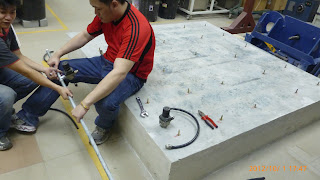The power of shaking thrust will be examined next by first controlling the megatorque motor rotation, and a digital control system for the motor needs to be thoroughly checked. Also actual acceleration and frequency that can be achieved by the shaking table need to be measured by placing accelerometers on the table.
When the set-up of shaking table test apparatus is completed, the apparatus will be used to first determine the dynamic properties of residual soil. This apparatus has been used successfully to examine various dynamic responses of model ground at RCUSS, Kobe University, Japan and especially of examining the liquefaction problems as shown below.
If you are interested in these facilities, please contact us at utar.earthquake@gmail.com.





